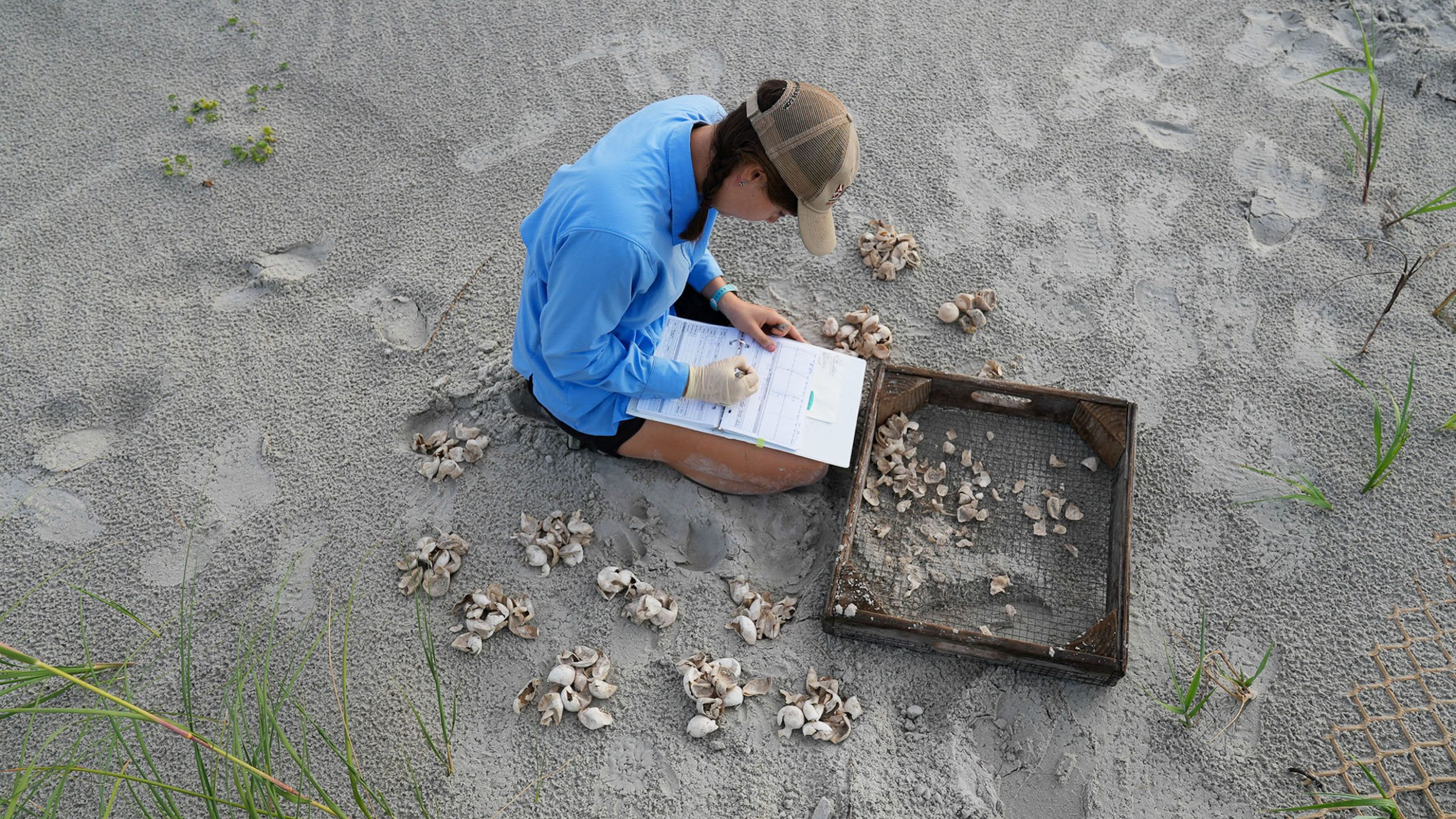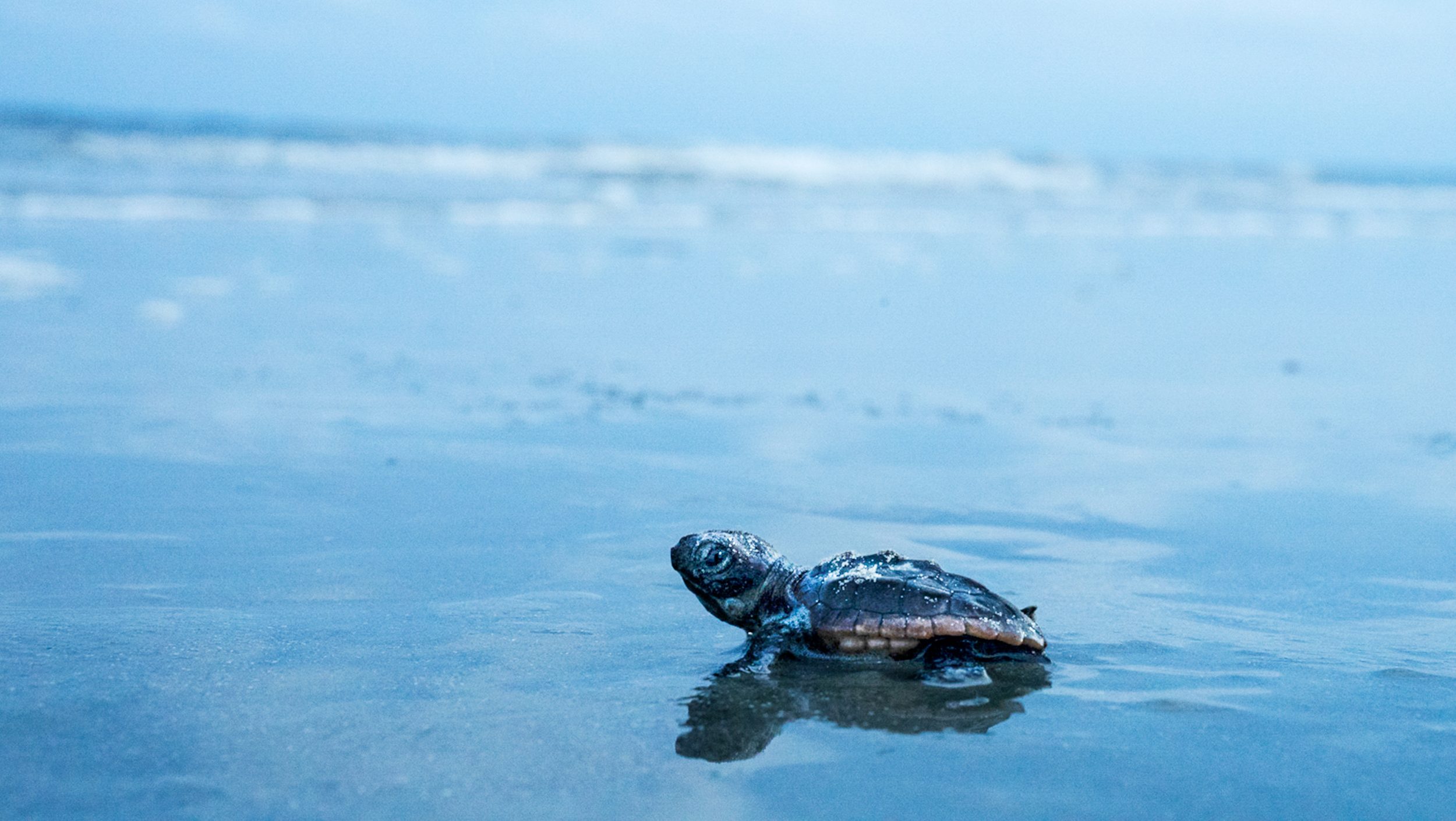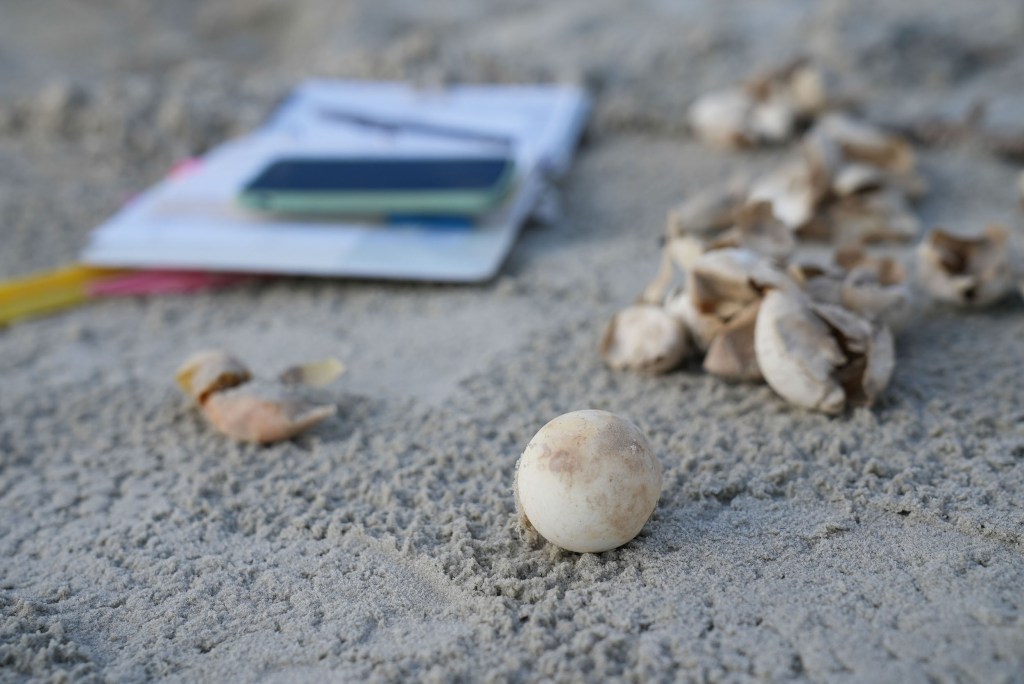Each morning in the summer of 2022, Karoline Perryman woke before dawn and walked the beach of Little Cumberland Island. Then a sea turtle technician for the Georgia Department of Natural Resources, Perryman was looking for tracks in the sand that would lead to newly laid nests. If she found one, she’d dig up to her elbows and pull out a single egg, destined not for the ocean, but for a lab 240 miles away at the University of Georgia.
Perryman was one of a host of seasonal “turtle boys and girls” hired by the Georgia DNR each year to monitor and help protect the nests of threatened loggerhead sea turtles. The state has coordinated turtle nest-tracking on its barrier islands since the 1980s and some islands have tracked their own nests much longer — Little Cumberland’s work began in 1964, making it the second-oldest sea turtle monitoring project in the world.
But for much of that history, nest monitoring has looked very different, says Russell Regnary, a resident of Little Cumberland Island and the coordinator of the sea turtle monitoring program there. “In the old days, they used to try and intercept the mother turtles as they were nesting and label them with a tag.” They took skin samples from the nesting turtles too.
That began to change in the mid-2000s. In 2005, University of Georgia researcher Brian Shamblin discovered that he could identify a mother sea turtle from a single egg she laid by cross-referencing DNA from the egg with those in the skin samples. The discovery would go on to change the way sea turtle nest monitoring is done on Little Cumberland and along many beaches from Georgia to Maryland.

An Egg Experiment
A loggerhead sea turtle egg is about the size of a ping-pong ball and surprisingly papery. It’s not firm like a bird’s egg. They take something like 60 days to hatch, and when a clutch of baby sea turtles all emerge from a sandy nest at once, it’s called a boil because that’s what the rippling sand looks like.
Loggerhead sea turtles live at sea, making their lives something of a mystery. Once a female loggerhead becomes sexually mature around 30 years old, it lumbers up a beach, often in the dead of night to lay a nest of maybe 150 eggs. She might lay multiple nests in a summer and disappear again for a few years. So, much of what we know about loggerhead population numbers comes from those nest counts.
“The challenge with that is females are laying multiple sets of eggs in a year. When you see fewer nests, does that really mean there are fewer females?” says Shamblin, today an associate research scientist for the University of Georgia. “You need their individual nesting history to tell you that.”
Shamblin was a graduate student at Georgia in 2005 when he got a call about an incident on Little Cumberland Island: A predator had attacked a freshly laid sea turtle nest and the sea turtle tech working that night, named Jocelyn Coulter, decided to freeze the remaining eggs. Coulter wanted to know if Shamblin could use the eggs to determine if the nesting turtle was one that had previously been tagged on that beach.
Nobody had done this with fresh sea turtle eggs before. “I just started playing with it and trying to figure out how can we maximize the signal from what was probably a really tiny amount of DNA,” Shamblin says. It worked. “They matched it to one of the skin samples they had. So that’s when the light bulb went off.”

The project, he knew, could have huge logistical ramifications on how sea turtle tracking was done. Not only did the monitoring then involve intercepting adult females and trying not to disturb their nesting activities, but more simply it involved a lot of work to monitor a beach overnight every night.
It also offered the tantalizing possibility of following sea turtles as they nested on multiple beaches rather than noting each time a sea turtle arrived at a single beach. At the time it was very common for a sea turtle tech to note a nesting turtle on their beach and then never log it again, raising the question of whether the turtle was gone or just nesting elsewhere.
But first the method had to be confirmed.
In 2006, Mark Dodd, a wildlife biologist with the Georgia Department of Natural Resources who coordinates the state’s sea turtle monitoring, set up a pilot study with Shamblin. Dodd asked certain beaches to collect duplicate eggs and skin samples. A lab at the University of Georgia extracted DNA from both and compared the samples to identify maternal DNA.
The pilot confirmed the process could work and, in 2008, “genetic tagging” went statewide in Georgia. Two years later, it expanded into South Carolina, North Carolina, Virginia and Maryland, home to a subpopulation of loggerheads known as the Northern Atlantic Recovery Unit. Today most turtle techs like Perryman work only in the mornings, collecting a single egg and covering the nest with a grate to keep out predators.

Meeting The Natal Neighborhood
Now Shamblin, Dodd and other loggerhead sea turtle researchers have well over a decade of data to pull from and an increasingly clear picture of what Shamblin calls “the natal neighborhood.”
“Essentially, we feel like we’ve tagged the entire [nesting] population,” says Dodd. “Now any new animals that show up, those are new females that are just nesting for the first time.”
The lab has identified more than 13,000 individual females. Meanwhile, the number of sea turtle nests, which hit a historic low in Georgia in 2004 just before the project began, have grown substantially. In 2022, Georgia counted a record number of loggerhead nests.
“A lot of our questions have shifted away from the sorts of things we can answer in a year—you know, how many females, how many clutches of eggs are they laying, how are they spreading out in space—to start addressing other questions that are really about population dynamics and what recovery looks like long term,” says Shamblin.

To that end, Dodd, working with Shamblin and others, began using that data to build a population model of loggerhead sea turtles to better answer some of those larger questions.
“It just demonstrates the value of long-term data and big-scale data,” says Dodd. “A lot of the questions that we’re able to answer now are only possible because of all the buy-in from all the monitoring folks over the entire subpopulation range and because we’ve been doing this so long.”
For Perryman, now a veterinary assistant in Atlanta, the research opens a window into the life of an otherwise mysterious creature. But, sometimes that summer in 2022, she still walked the beach in the dead of night to get a glimpse of the turtles themselves. Even just one glimpse would be enough.
“After I saw my first turtle in real life, it was like I honestly never have to see another one,” she says. “I can just do this work just knowing that they’re out there.”
Want to learn more about sea turtles? In the latest issue of Nature Conservancy magazine, “The Long Journey” tells the story of how land conservation efforts by The Nature Conservancy and others in Georgia have made space for some of the longest sea turtle monitoring projects in the world.




Join the Discussion
1 comment